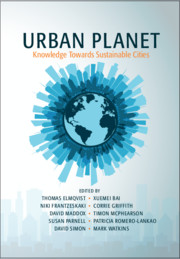Like most cities, Nairobi has its good sides: a national park, fabulous nightspots, and a vibrant, youthful population. Unfortunately, this young population is growing faster than employment opportunities; hence, many Nairobians must resort to informal work, such as street vending.
Street vendors, better known locally as “hawkers,” are the embodiment of what it is to survive in Nairobi. Out of sheer necessity, they break city bylaws with reckless abandon; they use any available street space to sell goods that range from insecticides to secondhand designer clothing. They also ingeniously display these goods on propped up carton boxes, which can be hurriedly folded up and sprung onto their backs as they dash off to escape the clutches of Nairobi City County, or NCC, officials. The NCC (colloquially referred to as kanjo) are themselves breakers of the law; they extort bribes and resort to violence in their frequent confrontations with the hawkers (Mungai Reference Mungai2016).
In its defense, the NCC, in its role as the local government of the city of Nairobi, is currently reviewing some of the city bylaws in a new attempt to bring order to downtown Nairobi. For instance, two large markets on the fringes of the city center have been designated for the hawkers (Odhiambo Reference Odhiambo2015). The hawkers, however, complain that they don’t get enough customers in those markets, so they troop back into the heart of the city, where they set up shop in front of banks, offices, and hotels. Thus continues the Nairobi hawker menace – a menace that is the obvious result of poor planning and bad management by the city.
Considering that Nairobi is Kenya’s capital, one would expect some foresight in its planning. Unfortunately, the city has expanded haphazardly and developed into fragmented neighbourhoods. There is an Integrated Urban Development Master Plan in the works (Niuplan 2016), but for now, Nairobians are left to their own devices. And this is not just the story of Nairobi; the development trajectory of most sub-Saharan African cities is haphazard, due in part to the inappropriateness of prevailing urban planning methods, which are, more often than not, borrowed from the Global North (Chen and Skinner Reference Chen, Skinner, Parnell and Oldfield2014).
To remedy the urban planning debacle in downtown Nairobi, some negotiations have taken place between three interest groups: the hawkers (who formed their own Nairobi Street Hawkers Association), the NCC, and the Nairobi Central Business District Association, which is made up of business owners (Kamunyori Reference Kamunyori2007). For such talks to bear fruit, Nairobi needs urban negotiators who can creatively facilitate inclusive dialogue.
One possible way to enhance city dialogues in Nairobi is through design thinking, which provides methods for understanding and facilitating long-term societal change via a user-centered, problem-focused approach (Brown and Wyatt Reference Brown and Wyatt2015).
A user-centered approach in planning Nairobi is urgently needed to ensure that the needs and knowledge of street hawkers and other vulnerable groups are brought to bear in developing the city. For example, the tacit design knowledge of street hawkers in navigating the city and dealing with daily challenges in downtown Nairobi could greatly enhance plans for better navigation and access in Nairobi’s streets.
Ultimately, the quest for sanity and order in Nairobi is a long-term project. Design thinking experts, along with other professionals, can better contribute to such a project if they can negotiate the clash between formal, informal, and even outright-illegal processes that, together, assemble Nairobi.



